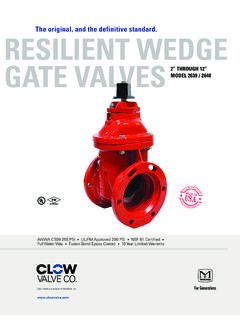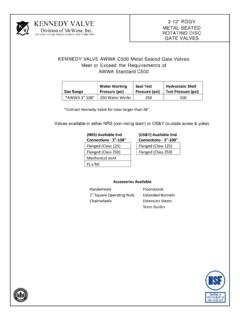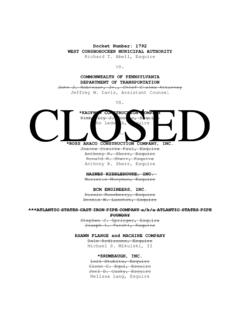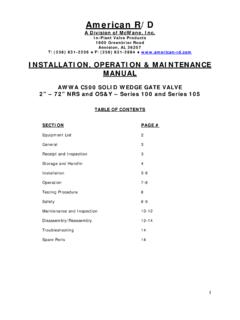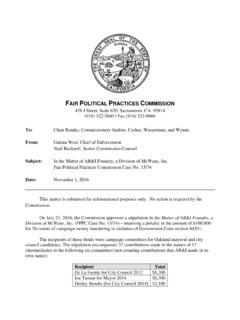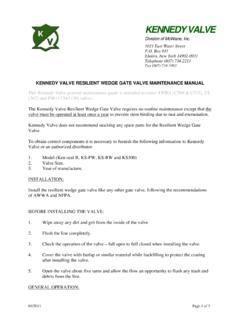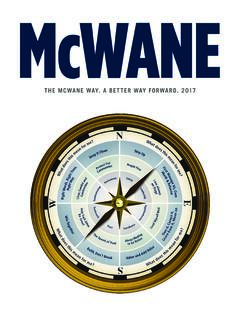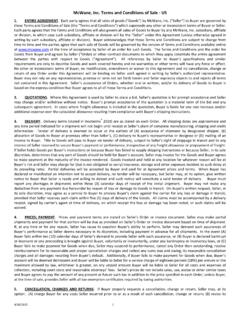Transcription of Division of McWANE, Inc. - M&H Valve
1 FIRE HYDRANT SUMMARIES The following information regarding AWWA C502 fire hydrants is provided in three separate documents to reflect aspects of installation, operation, and maintenance. The Installation section focuses on the aspects of the construction process, being the contract specification, installation and initial testing. This targets the interest of the pro-ject engineer, installer and construction inspector. The Operation section addresses the three most common operational factors that can result in damage to the hydrant or water system. This information should be considered by anyone who operates fire hydrants. The Maintenance information is supplemental to published maintenance manuals and provides a general review of the five key mechanical components. The short summaries provided represent only partial information. Detailed information is available within the AWWA C502 standard, or available from the manufacturer upon re-quest.
2 Division of mcwane , Inc. 605 West 23rd Street Box 2088 Anniston, AL 36202 Telephone (256) 237-3521 Fax (888) 549-5309 M&H Valve Co. FIRE HYDRANT INSTALLATION GENERAL Proper hydrant installation is an essential component to long service life with minimal maintenance. The following are some key fire hydrant installation, operation and trouble shooting procedures to consider when inspecting new construction. See the manufac-turers installation and maintenance manuals and the AWWA C502 Standard for Dry-Barrel Fire Hydrants for more detailed information. The operational requirement of the application needs to be fully specified to assure the installation complies with local standards. Operational requirements include: 1) Reference to AWWA C502 and/or other appropriate standard. 2) Main Valve size (5 typical) 3) Type & size of pipe connection (6 typical) 4) Depth of trench 5) Hydrant color 6) Nozzle configuration, sizes, and threading 7) Operating nut size and configuration 8) Direction of opening INSTALLATION DETAILS Be sure the hydrant selected corresponds to the depth of trench plus proposed adjust-ments to the finish grade.
3 Finish grade is recommended at 3 (+/-3 ) below break flanges, which is the designed optimum installation point for break system function. This also assures clearance for full circle operation of 15 hydrant cap wrenches. The auxiliary Valve & hydrant must be adequately restrained to the piping system. A mechanical joint connection is considered an unrestrained joint and requires thrust blocking or mechanical restraint. The hydrant needs to stand perpendicular. Directional facing of hydrant should provide access for fire fighting needs. All current production AWWA C502 hydrant models pro-vide for 360-degree barrel positioning options. , pg. 1 of 3 A gravel sump area must be provided at the hydrant shoe area to accept barrel drain-age. This stone filled area should be capable of containing a volume of water twice that held by the hydrant barrel.
4 Provide a stable and compacted backfill for installation rigidity. This will enhance func-tionality to the breakaway system. FUNCTIONAL DETAILS Check breakaway flanges or lugs for damage inflicted during handling & installation. Verification of break system integrity is an important functional inspection and also re-lates to operational safety. Operating nut sizes and nozzle threading must be checked for compatibility with fire de-partment standards. Direction to open must be as indicated by the arrow on the weath-ershield or bonnet and in compliance with local standards. OPERATIONAL TESTING Verify proper hydrant operation. Operate from behind - and not over the hydrant - mak-ing appropriate provisions to discharge flow. * Note that higher operating torques at ini-tial opening will be present due to resistance of line pressure. Once flow begins, pres-sure equalizes and operating resistance is minimized. The drain Valve system will discharge water from drain ports at line pressure during opening - in the one to five turn open range.
5 Prolonged hydrant operation must be only in the full open position to avoid undermining of the gravel sump area and backfill. Close hydrant very slowly to avoid a water hammer. If air is being discharged, stand clear of the hydrant and allow for discharge of all air before closing. Closure should be smooth and without significant resistance. Be sure the stem lock nut that retains the op-erating nut is secure and does not back out during closing. Line pressure aids in closing an AWWA C-502 center stem compression hydrants. There is no need to exert closing torque to retain closure. After full closure, relieve stem & seat assembly stress by turning the op nut approximately 1/4 turn in the open direc-tion. Debris lodged in the seating area of the main Valve - preventing full closure - is the most predominant seating problem with new installations. Water may flow out the nozzles or, in the case of a very minimal leak, be discharged thru the drain Valve system.
6 , pg. 2 of 3 It is somewhat common that hydrants are overtorqued in the closed position in attempt to overcome a seating obstruction. Difficulty in initial opening of the hydrant can be in-dicative of high torque seating achieved over debris (*also see above). Failure to achieve re-closure and hold closure with water pressure may indicate the main Valve has been damaged. Additionally, overtorquing can damage the operating nut threading, seat ring, or the breakaway assembly. A "rare possibility for full closure leakage would be a lower seat O-ring failure. In most cases, this O-ring proves to not be the problem upon further investigation. Check the hydrant barrel for proper drainage. After closing there should be a slight suc-tion at the hose nozzle, which is detectable with the palm of the hand. Failure to drain is usually caused by blockage of the drain ports due to improper installation.
7 Other less common possibilities include a high water table or the deletion of the drain feature as specified for some applications. SHELL TESTING A shell test will verify proper drain Valve facing operation and integrity of barrel compo-nent seals. When performing this test, special operational safety issues must be con-sidered. First, verify that all nozzles are positively retained to the barrel and caps are fully threaded on to the nozzles. Next, remove a nozzle cap and fill hydrant to the nozzle level then close and replace cap. This step will minimize air in the hydrant barrel as it is pressurized for shell testing. Always operate from behind and not over the hydrant. As the hydrant is re-opened, the drain system will be flushing in the 1 to 5 +/- turns open range. At full open the drain Valve facings will seal the drain ports as per AWWA C-502 sec "Hydrostatic test (AWWA C-502 allows for leakage at the drain Valve at a rate "not to exceed 5 fl oz/min ).
8 During a shell test, drain Valve sealing can usually be confirmed by the absence of sound associated with a flow operation. Damage to drain facings is not as common as in the past due to the use of pressure activated rubber fac-ings vs the leather drain Valve facings of the past. All nozzles, caps & barrel component seals should be drip tight. Barrel component leak-age is usually a result of loose shoe to lower barrel bolting. AWWA C502 and the manu-factures recommendations instruct the installer to check for bolts that may have worked loose in shipping and handling. , pg. 3 of 3 FIRE HYDRANT OPERATION GENERAL Maintenance requirements for AWWA C502 center stem compression fire hydrants are often a result of improper operation.
9 The most predominant issues are as follows: A) Water hammer - resulting from closing the hydrant too quickly. B) Over torquing in the closed position. C) Hydrant operation at less than full open. The following information is intended to be general in nature and may apply to all AWWA C502 hydrants. It is suggested to confirm operational procedures specific to each model. See maintenance information for additional details. A) CLOSING SPEED & WATER HAMMER The primary issue of concern is closing the hydrant too quickly - since this has the po-tential to extend damage beyond just the fire hydrant. It is critically important to close fire hydrants slowly - and also operate from behind and not over the hydrant. Water weighs about 8 lbs per gallon and may be moving at up to 4 feet per second and can't be stopped abruptly. When a hydrant is closed too quickly - a water hammer will result. Water hammer has a tremendous potential to damage water systems - as it slams against the closed hydrant and bounces back through the water system.
10 Adding some air into this picture we create a multiplier effect of water hammer. When a system is installed or repaired it is essential to properly bleed off any air within the pipe-line. Keep in mind that unlike water, air will compress and can create an extraordinary operational hazard. If you encounter air during operation, stay clear of the hydrant until the airflow ceases - and do not close while blowing off air! In some cases airflow can be very obvious during hydrant operation and in other cases, despite its presence, is not highly detectable. If hydrants chatter during operation - this should serve as a warning of the possible existence of air in the flow. , pg. 1 of 3 If hydrant chattering is common to specific areas of the water system, provisions should be considered to purge air. This is most likely to exist with hydrants at the high points of the system in conjunction with higher pressures and/or velocities. A hydrant with one or multiple extensions may contribute to this condition due to an accumulation of stem as-sembly tolerances.



![Untitled-1 [pe.mcwane.com]](/cache/preview/0/6/a/a/7/a/e/3/thumb-06aa7ae3820fc1a116eff00b799cf8bf.jpg)
